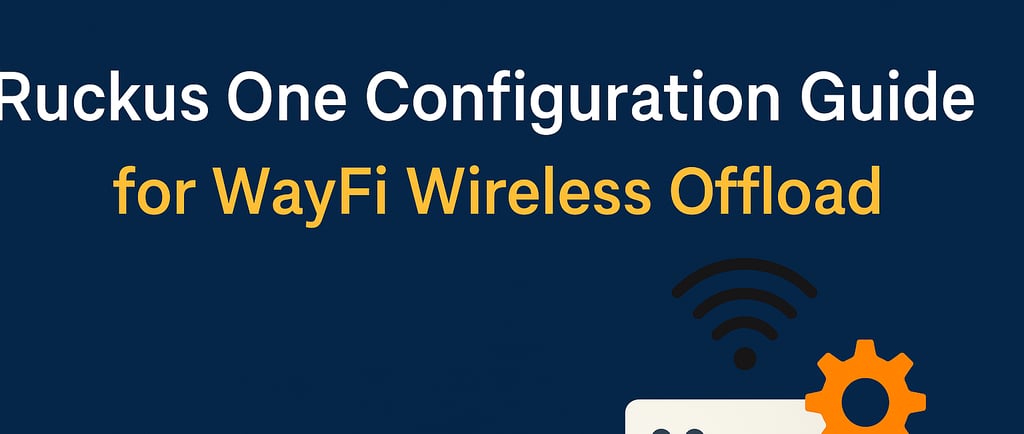Ruckus One Carrier Offload Configuration Guide for OpenRoaming and Passpoint for WayFi Wireless
Learn how to configure Hotspot 2.0 on Ruckus One for OpenRoaming and Passpoint, including best practices for identity provider setup, Wi-Fi operator profiles, RADIUS configuration, and advanced tuning settings.
GUIDES
WayFi Wireless
7/16/20253 min read


Ruckus One Configuration Guide for WayFi Wireless Offload
This article walks you through configuring a Hotspot 2.0 (Passpoint) SSID on Ruckus One for use with the WayFi Wireless roaming and carrier offload network. This includes identity provider setup, proxy RADIUS configuration, and advanced wireless and network control settings.
⚠️ Important: RadSec Support on Ruckus One
Ruckus One does not support RadSec (RADIUS over TLS) natively.
To ensure secure RADIUS communication, you must use a RADIUS proxy:
Option A: WayFi hosts the RadSecproxy for you (recommended)
Option B: You self-host the proxy using WayFi’s guidance
Your controller will use regular RADIUS (ports 1812 and 1813) to talk to the proxy, which forwards requests securely via RadSec to WayFi’s infrastructure.
Getting Started
Before you begin, make sure you have:
Access to your Ruckus One cloud dashboard
The MAC address of one access point at the site (used as NAS ID)
Proxy IPs and shared secret provided by WayFi (or your own deployment
A list of required realms, domains, PLMNs, and OIs from WayFi
Step 1: Create the SSID
Go to Wi-Fi Networks
Click Add Network
Enable Hotspot 2.0
Set the SSID to .WayFi Cellular Booster
Step 2: Configure Hotspot 2.0 Operator
Click Add next to Wi-Fi Operator, then enter:
Profile Name: WayFi
Domain:
Operator Friendly Name:
Language: English
Friendly Name: WAYFIWIRELESS
Click Add to save.
Step 3: Configure Hotspot 2.0 Identity Provider
Click Add next to Identity Provider, then complete the following sections:
Network Identifier
Profile Name: WAYFIWIRELESS
NAI Realms with EAP-TTLS
Add each of the following realms and configure them with EAP-TTLS:
NAI Realms for discovery only
Add the following realms without any EAP methods configured:
Add PLMN IDs
Click Add PLMN and enter each MCC/MNC combination:
311 / 180
313 / 100
310 / 280
310 / 410
310 / 150
Add Roaming Consortium OIs
Click Add OI and enter:
8c1f646810
f4f5e8f5f4
baa2d00000
00500f
5a03ba0000
004096
AAA Settings
Authentication Server
Profile Name: WayFi Proxy Auth
IP Address: (Provided by WayFi or your proxy)
Port: 1812
Shared Secret: radsec
Accounting Server
Profile Name: WayFi Proxy Accounting
IP Address: (Provided by WayFi or your proxy)
Port: 1813
Shared Secret: radsec
Click Next, then Add to complete the identity provider setup.
Step 4: VLAN Tab
VLAN Pooling: Disabled
VLAN ID: 1 (or your assigned VLAN)
Proxy ARP: Enabled
Step 5: Hotspot 2.0 Tab
Accounting Interim Updates: 5 minutes
Internet Access: Enabled
Access Network Type: Chargeable Public
IPv4 Address Type: Port-restricted address & single NATed address (Choose what is most accurate for the given location/venue)
Step 6: Network Control Tab
DNS Proxy: Disabled
Wi-Fi Calling: Disabled
Client Isolation: Enabled
Isolate Packets: Unicast
VRRP/HSRP Support: Disabled
Client Isolation Allowlist by Venue: Disabled
Anti-spoofing: Enabled
ARP Request Rate Limit: 15 ppm
DHCP Request Rate Limit: 15 ppm
Application Recognition & Control: Enabled
External Syslog Logging: Optional
Step 7: Radio Tab
Hide SSID: Disabled
Max Clients per Radio: 100
Load Balancing Between Radios: Enabled
Load Balancing Between APs: Enabled
BSS Min Rate (2.4 & 5 GHz): 12 Mbps
OFDM Only (Disable 802.11b): Enabled
Step 8: Networking Tab
Agile Multiband (AMB): Enabled
802.11k Neighbor Reports: Enabled
802.11d: Enabled
802.11r Fast BSS Transition: Enabled
Mobility Domain ID: 1
Airtime Decongestion: Optional (Recommended)
OCE: Optional (Recommended)
Step 9: Advanced Tab
Transient Client Management
Enabled
Join Wait Time: 30 seconds
Join Expire Time: 300 seconds
Join Wait Threshold: 10 clients
Optimized Connectivity Experience (OCE)
Enabled
Broadcast Probe Response Delay: 15 ms
Association Rejection Threshold: -75 dBm
Additional Options
GTK Rekey: Enabled
Multicast Filter: Enabled
Multicast Rate Limiting: Disabled (Auto disabled with Multicast Filter being Enabled)
AP Host Name in Beacon: Disabled
Wi-Fi 6/7: Enabled
Multi-Link Operation (MLO): Disabled (Client devices don't support this feature well yet)
BSS Priority: High
DTIM Interval: 3 (set in advanced radio settings if exposed) (Highly recommended due to iOS/MacOS issues)
Step 10: RADIUS Options
NAS ID Mode: User-defined
Custom NAS ID: Use lowercase MAC address of one AP (e.g., aabbccddeeff)
NAS Request Timeout: 20 seconds
NAS Max Retries: 3
NAS Reconnect Primary: 5 minutes
Called Station ID: WLAN BSSID
Final Notes
Your network is now fully configured for WayFi Wireless offload with Hotspot 2.0, EAP-TTLS support, OpenRoaming realms, and secure RADIUS integration via proxy.
Need Help?
WayFi Wireless can:
Host and manage your RADIUS proxy
Assist you with your own proxy setup
Review your Ruckus configuration
Introduction to Ruckus One Configuration
Configuring a hotspot 2.0 (Passpoint) SSID on Ruckus One can significantly enhance your wireless service management, especially when integrating with the Wayfi wireless roaming and carrier offload network. This guide will walk you through the necessary steps to ensure a seamless setup, covering key components such as identity provider setup, proxy radius configuration, and advanced options for wireless and network control.

WayFi Wireless
Helpful Pages
SUBSCRIBE TO OUR NEWSLETTER
© 2024 - 2025. All rights reserved.
Browser Extentions
TOOLS
